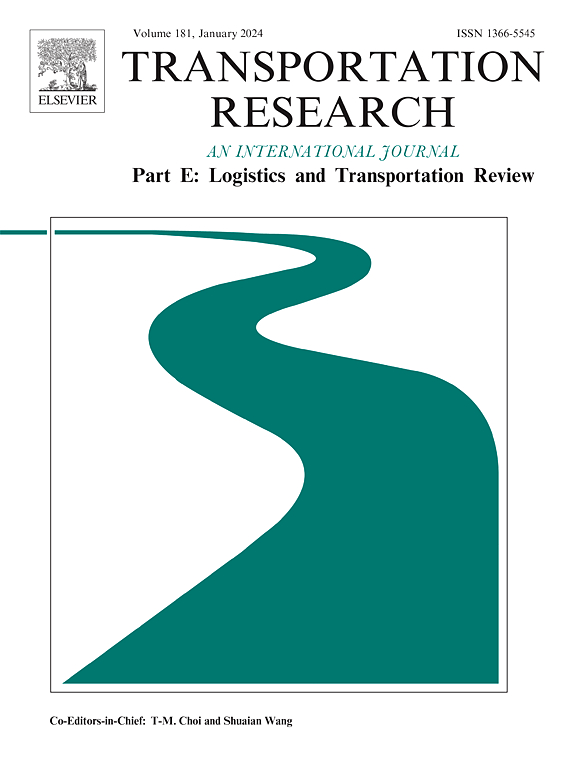Flight scheduling and pricing with high-speed rail coopetition and delay uncertainty
IF 8.8
1区 工程技术
Q1 ECONOMICS
Transportation Research Part E-Logistics and Transportation Review
Pub Date : 2025-05-28
DOI:10.1016/j.tre.2025.104219
引用次数: 0
Abstract
This paper explores flight scheduling and pricing strategies for airlines under coopetition with high-speed rail (HSR) in intercity travel markets, considering the impact of potential delays and missed connections on passenger choices. A stochastic user equilibrium model is developed to account for the passenger route choices under travel time variability, security control delays, and competition with HSR and other airlines. The model investigates coopetition between airlines and HSR operators to enhance profitability. Additionally, to address the capacity constraint, the model incorporates overbooking costs, accounting for passenger no-shows, the probability of exceeding flight capacity, and compensation costs by the operator. The proposed solution method employs decomposition, a variable neighborhood search method, and linearization techniques to address probabilistic terms and equilibrium conditions. A numerical case study focusing on the Europe-China market, considering demand from both long-haul and short-haul travel, evaluates the impact of changes in HSR travel times and fares on passenger choices. Our results show that reduced HSR travel times shift passenger demand away from flights and lead flight operators to terminate some short-haul services, while increased HSR fares boost flight demand, particularly on long-haul routes. The study further illustrates the policy of reducing flights in response to a more severe competition due to shorter flight transit time. The optimal pricing strategy produces similar fares for the connecting itinerary through a local transfer hub and direct itinerary to the transfer hub.
高铁合作与延误不确定性下的航班调度与定价
本文探讨了航空公司在城际旅游市场中与高铁(HSR)合作的航班调度和定价策略,考虑了潜在的延误和错过的连接对乘客选择的影响。建立了一个随机用户均衡模型,以考虑乘客在旅行时间变化、安全控制延误以及与高铁和其他航空公司竞争下的路线选择。该模型考察了航空公司和高铁运营商之间的合作,以提高盈利能力。此外,为了解决容量约束问题,该模型结合了超售成本,考虑了乘客未到、超过航班容量的概率和运营商的补偿成本。提出的求解方法采用分解、变量邻域搜索方法和线性化技术来处理概率项和平衡条件。一项以中欧市场为研究对象的数值案例研究,考虑了长途和短途旅行的需求,评估了高铁旅行时间和票价的变化对乘客选择的影响。我们的研究结果表明,高铁旅行时间的减少使乘客对航班的需求减少,并导致航班运营商终止了一些短途服务,而高铁票价的增加则促进了航班需求,特别是在长途航线上。该研究进一步说明了减少航班的政策,以应对更激烈的竞争,由于更短的飞行过境时间。最优定价策略对于通过本地转乘枢纽和直接前往转乘枢纽的路线产生相似的票价。
本文章由计算机程序翻译,如有差异,请以英文原文为准。
求助全文
约1分钟内获得全文
求助全文
来源期刊
CiteScore
16.20
自引率
16.00%
发文量
285
审稿时长
62 days
期刊介绍:
Transportation Research Part E: Logistics and Transportation Review is a reputable journal that publishes high-quality articles covering a wide range of topics in the field of logistics and transportation research. The journal welcomes submissions on various subjects, including transport economics, transport infrastructure and investment appraisal, evaluation of public policies related to transportation, empirical and analytical studies of logistics management practices and performance, logistics and operations models, and logistics and supply chain management.
Part E aims to provide informative and well-researched articles that contribute to the understanding and advancement of the field. The content of the journal is complementary to other prestigious journals in transportation research, such as Transportation Research Part A: Policy and Practice, Part B: Methodological, Part C: Emerging Technologies, Part D: Transport and Environment, and Part F: Traffic Psychology and Behaviour. Together, these journals form a comprehensive and cohesive reference for current research in transportation science.

 求助内容:
求助内容: 应助结果提醒方式:
应助结果提醒方式:


